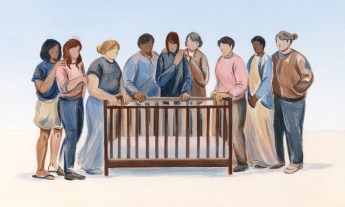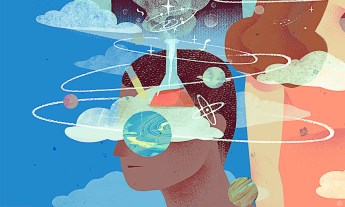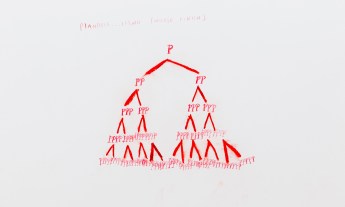
Inspired by a book on silence, a director set out to explore and capture its many manifestations on film. The problem? Silence is much more slippery than he realized.
Even before the omnipresent cacophony of modern life, people were seeking, pondering and preaching the elusive refuge of silence. It’s a key component of virtually every major religion — Hinduism, Christianity, Islam, Taoism. But considering today’s constant din of smartphone alerts and urban clatter, it’s become an even more elusive endeavor.
That is more or less what director Patrick Shen set out to do in his documentary Pursuit of Silence, which was released in the US in 2016. True to his subject, he opens the film with actual silence: 4 minutes and 33 seconds of it, an ode to avant-garde musician John Cage’s 1952 musical composition titled “4′ 33″,” in which a pianist sits at a piano without playing a note. The film’s first words spoken are by author Helen Lees, the author of Silence in Schools, who asks, “How do you talk coherently about silence?”
It’s a good question — and as Shen discovers, a hard one — which he attempts to answer through interviews with authors and scientists, balanced by cinematic representations of our sometimes silent but often very noisy world. Shen details the myriad meanings and strange contradictions he found exploring the cultural, political and physical aspects of silence, and tries to explain what makes it such an appealing — yet uncomfortable — state to achieve and maintain.
Silence is golden
First, the obvious. Silence is most often tied to tranquility in nature, like a quiet sunset, a still forest. The hushed contentment of a sleeping baby pleases parent and child alike. And many religions have long correlated silence with contemplation of and reverence for gods or eternity. Early Hindu philosophy called silence “mauna,” linked it to inner peace and deemed it crucial to the pursuit of self-knowledge. Lao-Tze, the father of Taoism, with its ethic of wu-wei, or “not doing,” called silence “a source of great strength.” In the Bible, silence is tied to wisdom, patience, understanding and submission; as a tart maxim from Proverbs observes, “Even a fool, when he keeps silent, is considered wise.” It certainly appeals to thought: Herman Melville, Pablo Neruda and Susan Sontag are just a few of the many thinkers who have rhapsodized about the different presences silence can have. Silence has a surprising number of social functions as well. It can be a way of showing respect, attentiveness or consideration to someone else. Silence can be affectionate or intimate, or, in the form of a pause, can bestow import, emotion or gravitas on those words we do say.
Silence is leaden
Shen was also interested in how many negative connotations silence has. Despite the exalted place silence holds in many religions, there seem to be more sayings in favor of speaking up than shutting up — the squeaky wheel gets the grease, to name but one. Silence can mean something feels wrong, like the awkward silence in a conversation or the sense of foreboding in the calm before a storm. And silence can be far from peaceful. Authoritarian governments silence their critics; the “silent treatment” is a slippery act of passive hostility. And it can equal cowardice; as Martin Luther King once observed, “We will remember not the words of our enemies, but the silence of our friends.” And we all know what happened when King Lear’s favorite daughter Cordelia decided to “love and be silent.”
Silence is healthy
Whatever bias there is against silence, the bias against noise is a lot louder — for good reason. The World Health Organization has identified noise pollution as a global health hazard affecting both developing and developed nations. The impact includes hearing impairment, sleep disturbance, mental-health effects, hypertension and increased blood pressure. People surrounded by noise are often in constant states of stress, which can degrade their immune systems. Children who are exposed to noise — like the New York City kids featured in the film whose school abuts train tracks — are at risk of having their cognitive learning abilities impaired. A 2011 WHO report concluded that in Europe at least 1 million life-years are lost every year from the long and short-term effects of traffic-related noise. (And yet, as a former teenage heavy metal guitarist, Shen says he’s not a silence snob. “I have a soft spot for noise,” he says. “I appreciate how it can make us feel more alive.”)
Silence is ethereal
“Silence is a doorway to a truth, into a realm beyond words,” says Shen says, who wrestled with how much spoken wisdom from experts like Pico Iyer, Julian Treasure, and Susan Cain to include in the film. “We strive so much to define the world and put words to it and understand it, but that’s where we get into trouble.” Um, what does that mean, exactly? Well, that’s part of the deal with silence. Unlike a sound you can actually utter or hear, shape-shifting silence can represent anything you want, part of the reason that the practice of silence has been integral to religions around the world.
Silence is escape
One character in the film is Greg Hindy, a 22-year-old Yale graduate who in 2013 went on a yearlong pilgrimage across America without speaking a word. By stepping away from the ever-present hum of technology and culture, Hindy hoped to get insight on what he really wanted to take in from the world around him. “Time away has given me perspective on what I should allow back into my life,” he writes in the film. “Many people wanted a reason for the silence. I tried to explain that we can come up with reasons for doing anything, but only in doing it can we really understand it. My intuition was that it was a good thing to do, that silence is important in many ways and should be explored, not explained.”
Silence is strange
Shen also films at Minneapolis’ Orfield Laboratories, a light and acoustics testing facility that houses one of the quietest places on earth. Its anechoic (“free from echo”) chamber, made of fiberglass and insulated steel and concrete, has been measured at -9 decibels. An average room is about 30 decibels. Shen also spent some time in the chamber. “When sound leaves your mouth, there is no surface that it can bounce from — it literally dies,” Shen says, describing it as “the most deafening experience of my life.” He was so busy trying to figure out what he should get out of the experience, he says, that when he settled down, the phenomenon was just plain weird. “It was very disorienting and kind of depressing,” Shen says. “I am still very much chasing silence.”
The film also features a voiceover by John Cage, music’s most famous silentician, who once also sought an anechoic chamber in hopes of finding the quietest place on earth. But he got a surprise. “I heard in that room two sounds — one was high and one was low — and I thought there was something wrong with the room. I went outside and found the engineer in charge, and he said, “The high one is your nervous system in operation and the low one is your blood circulating.” And Cage realized how subjective, how nebulous and how abstract the idea of silence really was.
Silence is balance
The writer George Prochnik, whose 2011 book In Pursuit of Silence, inspired Shen to make the film, seems to understand silence the best. “When we throw around the term of silence, we may in the first instance imagine that we’re seeking some kind of absolute quiet, but very very few people look for that,” says Prochnik in Shen’s film. “What we’re looking for, I came to believe, is really more for a kind of balance in our environment. It’s the particular balance of sound and quiet that maximizes our perceptual awareness of where we are.”
Silence is subjective
In short, silence is kind of like water. In its most highly purified, laboratory-made state, ultrapure water (used as a solvent in the semiconductor industry) has a distinctly strange and unpleasant taste and can even leach minerals out of your body. It turns out that what makes water taste good to us are the various trace minerals, the temperature of the water, the temperature of the room, how thirsty we are and so on. It’s not pure silence we are after. It’s the special silence unique to every person — with your favorite trace elements of sounds, smells and visuals — that replenishes you and restores what the noisy world has stripped away. That is the silence worth pursuing.














